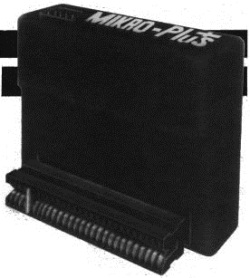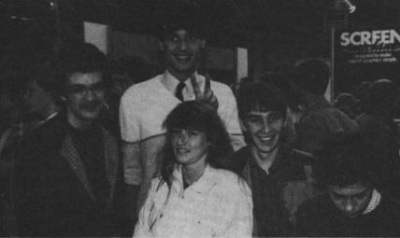
The add-on that makes it all possible — the Mikro Plus
GRAEME KIDD and JEREMY SPENCER pay a visit to the land of High Technology and very short stay car parks, Bracknell, home of Mikro-Gen
MIKRO-GEN are not well known for their hardware add-ons. In fact their last dabble into that market was with the very first ZX81 joystick (ZX81: an early 1K sub-£100 machine with built in BASIC and membrane keyboard — Galactic Encyclopaedia, Early Earth Computers). Their latest project, the Mikro-Plus promises to make a much greater impact on the Spectrum world.
How often have you heard that computer games could be infinitely better if only there was more memory in which to put the things. Way back in the good old days, Imagine promised us a ‘mega game’ that would only be possible through an extra box of bits stuck onto the back of a Spectrum. We held our breaths; and nearly asphixiated. But, if any of you are still without breath you can relax. Mikro-Gen have taken over where Imagine failed to tread. At this year’s PCW Show they are launching an add-on and two games that they hope will set new standards for Spectrum software.

The add-on that makes it all possible — the Mikro Plus
As we all know, the Spectrum uses the Z80 processor which is capable of addressing 64K bytes of memory. Of that 64K only about 42K odd is available for use by software, the rest is either screen working space or taken up by the 16K monitor program. The monitor program is responsible for storing the machine code routines that perform all of the operations we take for granted. For example if you want your Spectrum to print a flashing character to the screen it will have to look up the machine code operations that it needs to do this — and the instructions are held in the form of routines inside the ROM. If you can replace the Sinclair ROM chip with one of your own, with your own routines built into it, you could alter the entire machine. There are disc systems which, while they don’t physically remove the Spectrum chips, are able to mask or shadow them. With the shadow ROMs in place the disc can download the routines of its own; the Spectrum can be changed into a dedicated word processor, or communications terminal.
The ability to shadow the monitor ROM is not in itself new, it’s an old trick and the BBC and Amstrad machines have such facilities built in. Mikro-Gen have put together a piece of hardware which replaces the Spectrum instructions with code for a game: the rest of the game is loaded in from the cassette. But, the real breakthrough is the price — £14.95 will get you a complete hardware and software package.
The hardware itself looks rather like a joystick interface and conveniently enough it has one of those built in. With this unit plugged into the Spectrum the programmer can put together a program 50% larger than is usual, Mike Meek of Mikro-Gen claims. Because routines designed specifically for that particular game can be put into the chip the memory of the whole machine can be used more efficiently. The built in joystick port is a good example: memory does not have to be wasted catering for a number of different joystick protocols. Some areas of the Spectrum’s memory are shared by other functions, those ‘slow’ areas cause delays in accessing the routines. Up till now programmers have had little choice, they had to use what memory was available. Now the fastest areas of memory can hold the code that does the hard and fast work. Filled in vector graphics can become a reality.
Because of the extra space available and because specific routines can be tailored for each game, Mikro-Gen are able to add extra features. Two such features are planned to appear in the first two releases. The first allows users to make a microdrive copy by giving a single command, the routine will do the rest. Mikro-Gen’s Mike Meek feels strongly about the problems caused by poor cassette recorders and so wants an Azimuth alignment routine built into the Plus. More and exciting extras are being considered for the future.

A group of Wally programmers!
Initially the system will be launched with two games, Battle of the Planets and Shadow of the Unicorn. Each one comes complete with cassette and the add-on, the add-on being specific to the individual game. Battle of the Planets is a massive, superbly animated arcade shoot-’em-up split into three linked, but separate games. ‘I would feel happy selling each part of the game separately,’ Mike told us, ‘so all three together we see as a real blockbuster’.
The second game, Shadow of the Unicorn is a role playing adventure featuring ten individual characters where Everyone’s a Wally had only five. The game is so involved that a book is provided to set the scene for the game.
The future possibilities for this system are fantastic. If volume sales take off as expected then the games will soon cost even less than the £14.95 you’ll have to fork out at the start. Some software houses are tentatively talking about licencing deals. Asked what Uncle Clive thought about the system Mike replied, ‘Well I can tell you that there is a definite tie-up between ourselves and Sinclair Research. I do know what Sinclair’s plans are but we have signed a non-disclosure agreement and intend to abide by it.’
We tied Mike to the chair and threatened to nail his hands to the table. ‘Tell us this Mike, are these plans going to help Sinclair,’ (ready the nails). ‘No... (hammer raised) yes — no question about it.’
Sinclair aside, Mikro-Gen’s hardware could represent one of the most exciting developments the Spectrum has seen for a long time. When you look at the deal, a superb game, a built in joystick interface, a microdrive routine and an Azimuth alignment routine all for £14.95 I think you will agree that Mike’s pet term ‘megagame’ sits on Mikro-Gen’s shoulders more easily than it ever did on Imagine’s. And it couldn’t have come from a nicer bunch of Wally....
JS